
Image credit: J.Chumack, A. Rosner, & L. Venter. Click to enlarge

Image credit: J.Chumack, A. Rosner, & L. Venter. Click to enlarge
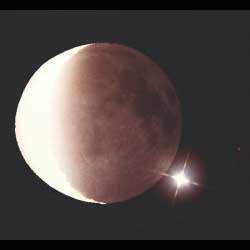
The Moon and Venus Credit: Robert Sandy
Monday, August 8 – About an hour after sunset, look for the crescent Moon low in the west/southwest for northern hemisphere viewers. Check out Venus less than a fist’s width to its lower right and Jupiter less than a handspan to upper left. We’ll keep watch this week as the Moon passes by Jupiter and bright stars – Spica and Antares.
For viewers in Alaska, here’s a unique opportunity… Tonight you’ll have a chance to see the Moon occult Venus! Need a time for your location? Then look no further than this IOTA webpage. For our friends in the UK, you will have the opportunity to watch the Moon occult Beta Virginis tonight. Please check this IOTA webpage for listings of times and cities in your area. Wishing you both clear skies…
For the rest of us, take the time tonight to really study the fully emerged Mare Crisium region telescopically. Look for the small punctuation of craters Pierce toward the northwestern area and Pickard to its south. Can you make out the bright peninsula of Promentorium Agarum on the eastern shore?
Tuesday, August 9 – Tonight after sunset, look again at the crescent Moon and you’ll discover that Jupiter now sits a few scant degrees above its left shoulder. When the stars begin to appear, look for bright Spica about a fist width south of Jupiter.
Tonight we’ll have a look at the smooth sands of Mare Fecunditatis to the lunar south. Binoculars will see the bright, shallow ring of Langrenus on its eastern shore. For telescopic users, this is a great opportunity to pick up two small challenge craters located just northwest of central in Fecunditatis – crater Messier to the east and its companion crater Messier A to the west.
Wednesday, August 10 – For viewers along the eastern sections of both Canada and the US, get your binoculars out and have a look at the Moon right after sunset. Just below the southern cusp you will spot Spica. Watch over the next two hours as the skies fully darken and the distance between them widens as the pair sets.
On the lunar surface, look for the three rings of Theophilus, Cyrillus and Catherina on the edge of Mare Nectaris to the south. A bit further south, you will note a long bright feature known as Rupes Altai, or commonly referred to as the Altai Scarp. This 967 km (600 mile) long feature stretches in an arc from crater Piccolomini through the south shore of Mare Tranquillitatus. While its height doesn’t exceed more than 1.6 – 3.2 km (1 to 2 miles), lunar sunrise highlights it to perfection and you will notice that it is much stronger to the south.
Thursday, August 11 – On this date in 1877, Asaph Hall of the U.S. Naval Observatory was very busy. Tonight would be the first time he would first see Mars’ outer satellite Deimos! Six nights later, he observed Phobos, giving Mars a grand total of two moons. Be sure to watch as Mars begins rising around midnight.
Tonight is the peak of the Perseid meteor shower, but we’ll need to kill about three hours until the Moon sets. If you can’t nap, then look for Venus low on the horizon and notice that Jupiter and Spica are slightly closer together. On the lunar surface, binoculars will see the central Mare Tranquillitatus. For telescope users, on its eastern shore you will see the small bright ring of crater Arago – but don’t stop there. Continue east towards the terminator and watch for a thin, black line that cuts through the foothills. While most rilles are usually within mare areas, the Rimae Ariadaeus is one of the few sufficiently wide enough to be spotted against such a bright background. Running around 233 km (145 miles) long, this is known as a Graben type depression and it only averages around 1.6 – 3.2 km (1 – 2 miles) wide. Although it appears relatively straight, it’s actually a collection of offset segments.
Now let’s sit back and talk about the Perseids while we watch…
The Perseids are undoubtedly the most famous of all meteor showers and never fail to provide an impressive display. Its activity appears all the way back to 36 AD in Chinese history. In 1839, Eduard Heis was the first observer to give an hourly count and discovered their maximum rate was around 160 per hour at that time. He, and other observers, continued their studies in subsequent years to find that number varied.
Giovanni Schiaparelli was the first to relate the orbit of the Perseids to periodic comet Swift-Tuttle (1862 III). The fall rates have both risen and declined over the years as the Perseid stream was studied more deeply and many complex variations discovered. There are actually four individual streams derived from the comet’s 120 year orbital period which peak on slightly different nights, but tonight is our accepted peak.
Meteors from this shower enter Earth’s atmosphere at a speed of 60 km/sec (134,000 miles per hour), from the general direction of the border between the constellations Perseus and Cassiopeia. While they can be seen anywhere in the sky, if you extend their paths backward, all the true members of the stream will point back to this region of the sky. For best success, position yourself so you are generally facing northeast and get comfortable. The radiant will continue to climb higher in the sky as dawn approaches. Around midnight, watch as Mars joins the show and Saturn honors us in the east about an hour before sunrise.
Wishing everyone success!
Friday, August 12 – Practice astronomy in the daytime? Why not! When the Sun reaches its highest point today in the northern hemisphere, you see the Moon rising in the southeast. Watch as the skies darken and you’ll discover red Antares about a handspan to its left.
Tonight let’s return to the lunar surface to pick up another surface “scar”. In the north you will see the rugged terrain of the Montes Alpes. Look for the deep, diagonal gash of the Alpine Valley cutting through them. This artificial looking feature runs around 177 km (110 miles) long and ranges anywhere from 1.6 – 21 km (1 – 13) miles wide. It’s a very curious feature and may very well be a reminder of a glancing blow dealt by a large meteoritic body.
Saturday, August 13 – Tonight Antares is less than a fist width away from the waxing gibbous Moon. On the lunar surface, we can enjoy another strange, thin feature as well. Look toward the lunar south where you will note the prominent rings of craters Ptolemaeus, Alphonsus, Arzachel, Purbach and Walter descending from north to south. Just west of them, you’ll see the emerging Mare Nubium. Between Purbach and Walter you will see the small, bright ring of Thebit with a crater caught on its edge. Look further west and you will see a long, thin, dark feature cutting across the mare. Its name? Rupes Recta – better known as “The Straight Wall”. It is one of the steepest known lunar slopes rising around 366 meters (1200 feet) from the surface at 41 degree angle.
Sunday, August 14 – Look again at the sky tonight as Antares has now moved to the other side of the Moon! For New Zealand and Australia, you will have the chance to see the Moon occult Sigma Scorpii. You can find details on this IOTA webpage. On this same night, viewers in central northern Australia (in the Broome/Darwin area) will also have a chance to see the Moon occult Antares. Please check this IOTA webpage for precise times.
For lunar binocular viewers this evening, two wonderful features are readily awaiting you. Look for the smooth, dark oval of Plato to the north and the emerging grandeur of Copernicus almost central to the terminator. Can you see the wonderful Archimedes between the two – or Eratosthenes hanging onto the tail of the Apennine Mountains?
Until next week, may all your journeys be at light speed…~Tammy Plotner

Peas growing onboard the International Space Station. Image credit: The crew of ISS Expedition 6, NASA. Click to enlarge
Anxiety can be a good thing. It alerts you that something may be wrong, that danger may be close. It helps initiate signals that get you ready to act. But, while an occasional bit of anxiety can save your life, constant anxiety causes great harm. The hormones that yank your body to high alert also damage your brain, your immune system and more if they flood through your body all the time.
Plants don’t get anxious in the same way that humans do. But they do suffer from stress, and they deal with it in much the same way. They produce a chemical signal — superoxide (O2-) — that puts the rest of the plant on high alert. Superoxide, however, is toxic; too much of it will end up harming the plant.
This could be a problem for plants on Mars.
According to the Vision for Space Exploration, humans will visit and explore Mars in the decades ahead. Inevitably, they’ll want to take plants with them. Plants provide food, oxygen, companionship and a patch of green far from home.
On Mars, plants would have to tolerate conditions that usually cause them a great deal of stress — severe cold, drought, low air pressure, soils that they didn’t evolve for. But plant physiologist Wendy Boss and microbiologist Amy Grunden of North Carolina State University believe they can develop plants that can live in these conditions. Their work is supported by the NASA Institute for Advanced Concepts.
Stress management is key: Oddly, there are already Earth creatures that thrive in Mars-like conditions. They’re not plants, though. They’re some of Earth’s earliest life forms–ancient microbes that live at the bottom of the ocean, or deep within Arctic ice. Boss and Grunden hope to produce Mars-friendly plants by borrowing genes from these extreme-loving microbes. And the first genes they’re taking are those that will strengthen the plants’ ability to deal with stress.
Ordinary plants already possess a way to detoxify superoxide, but the researchers believe that a microbe known as Pyrococcus furiosus uses one that may work better. P. furiosus lives in a superheated vent at the bottom of the ocean, but periodically it gets spewed out into cold sea water. So, unlike the detoxification pathways in plants, the ones in P. furiosus function over an astonishing 100+ degree Celsius range in temperature. That’s a swing that could match what plants experience in a greenhouse on Mars.
The researchers have already introduced a P. furiosus gene into a small, fast-growing plant known as arabidopsis. “We have our first little seedlings,” says Boss. “We’ll grow them up and collect seeds to produce a second and then a third generation.” In about one and a half to two years, they hope to have plants that each have two copies of the new genes. At that point they’ll be able to study how the genes perform: whether they produce functional enzymes, whether they do indeed help the plant survive, or whether they hurt it in some way, instead.
Eventually, they hope to pluck genes from other extremophile microbes — genes that will enable the plants to withstand drought, cold, low air pressure, and so on.
The goal, of course, is not to develop plants that can merely survive Martian conditions. To be truly useful, the plants will need to thrive: to produce crops, to recycle wastes, and so on. “What you want in a greenhouse on Mars,” says Boss, “is something that will grow and be robust in a marginal environment.”
In stressful conditions, notes Grunden, plants often partially shut down. They stop growing and reproducing, and instead focus their efforts on staying alive–and nothing more. By inserting microbial genes into the plants, Boss and Grunden hope to change that.
“By using genes from other sources,” explains Grunden, “you’re tricking the plant, because it can’t regulate those genes the way it would regulate its own. We’re hoping to [short-circuit] the plant’s ability to shut down its own metabolism in response to stress.”
If Boss and Grunden are successful, their work could make a huge difference to humans living in marginal environments here on Earth. In many third-world countries, says Boss, “extending the crop a week or two when the drought comes could give you the final harvest you need to last through winter. If we could increase drought resistance, or cold tolerance, and extend the growing season, that could make a big difference in the lives of a lot of people.”
Their project is a long-term one, emphasize the scientists. “It’ll be a year and a half before we actually have [the first gene] in a plant that we can test,” points out Grunden. It’ll be even longer before there’s a cold- and drought-loving tomato plant on Mars–or even in North Dakota. But Grunden and Boss remain convinced they will succeed.
“There’s a treasure trove of extremophiles out there,” says Grunden. “So if one doesn’t work, you can just go on to the next organism that produces a slightly different variant of what you want.”
“Amy’s right,” agrees Boss. “It is a treasure trove. And it’s just so exciting.”
Original Source: NASA News Release
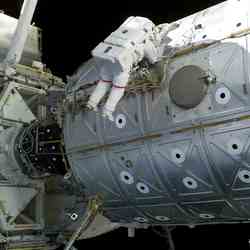
Mission specialist Soichi Noguchi. Image credit: NASA Click to enlarge
Discovery’s seven astronauts will spend another day in space after weather conditions at the Kennedy Space Center landing site prevented a return to Earth today.
Discovery’s two landing opportunities to Florida were waved off this morning due to unpredictable cloud cover at the landing site.
All three primary Shuttle landing sites will be activated on Tuesday. NASA’s Kennedy Space Center, Florida, will remain the preferred landing site. Edwards Air Force Base, California, will be second in preference for landing and White Sands Space Harbor, New Mexico, will be third in preference. Two Shuttle landing opportunities will be available at each site.
Weather conditions at KSC for Tuesday are forecast to be similar to today with a slight chance of showers offshore. Edwards is forecast to have acceptable conditions for landing. White Sands’ forecast includes a chance of showers.
Preparations are now focused on the first opportunity to land Tuesday which would begin with an engine firing by Discovery at 3:01 a.m. CDT and lead to a touchdown at KSC at 4:07 a.m. CDT. The additional landing opportunities include: a 4:33 a.m. Shuttle engine firing leading to a 5:39 a.m. landing at White Sands; a 4:37 a.m. engine firing leading to a 5:43 a.m. touchdown at KSC; a 6:06 a.m. engine firing leading to 7:12 a.m. touchdown at Edwards; a 6:09 a.m. engine firing leading to a 7:13 a.m. landing at White Sands; and a 7:44 a.m. engine firing leading to a 8:47 a.m. landing at Edwards.
The Shuttle crew will fire Discovery’s engines at 7:19 a.m. today to adjust the Shuttle’s orbit and optimize the landing opportunities for tomorrow. The crew will go to sleep at 11:39 a.m. and awaken at 7:39 p.m. to begin deorbit preparations.
Original Source: NASA News Release
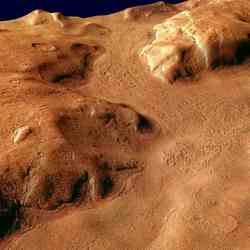
Perspective view of Reull Vallis. Image credit: ESA Click to enlarge
The Mars Reconnaissance Orbiter, set to launch on August 10, will search for evidence that liquid water once persisted on the surface of Mars. This orbiter also will provide detailed surveys of the planet, identifying any obstacles that could jeopardize the safety of future landers and rovers.
Jim Graf, Project Manager for the Mars Reconnaissance Orbiter, gave a talk where he provided an overview of the mission. In part one of this edited transcript, Graf discusses previous studies of Mars, and describes the steps that will put MRO in orbit around the Red Planet.
“In the 1900s, our knowledge of Mars was based on looking at albedo features, the bright and dark spots. And, guess what? They moved all over. We didn’t know about the dust storms that cover the planet, since all we could do was look at Mars through a telescope from afar. We also saw a lot of straight lines, and some people believed those lines were canals that brought water from the poles down to the arid regions. There were little green men running around in oases all over.
Fast-forward sixty-five years to when Mariner 4 came by, we saw a moon-like surface: craters, no real water, devoid of life, no Martians, no oases, no canals. At that particular point in time we said, ‘There’s nothing really there. Let’s go look elsewhere.’ But thankfully, future Mariners were in the queue and already had been approved for going to Mars to investigate it more thoroughly. When they arrived there, our image of Mars changed. We saw evidence that water once flowed on the surface. There were craters that had been partly subsumed, crater walls that were partly destroyed as if water flowed by. Other images showed almost delta-like regions, where water had been captured in one area and then came down in streams and gullies.
The wide angle view of the martian north polar cap was acquired on March 13, 1999, during early northern summer. The light-toned surfaces are residual water ice that remains through the summer season. The nearly circular band of dark material surrounding the cap consists mainly of sand dunes formed and shaped by wind. Credit: NASA/JPL/Malin Space Science Systems
We’ve had a lot of orbiters since the Mariner missions, and not only do we see water features in the land, but we also see evidence of tectonics, or possibly volcanic activity. Olympus Mons is the largest volcano in the solar system. Valles Marineris, named after the Mariner spacecraft that found it, is 4,000 kilometers wide, the same distance across as the United States, and it’s 6 kilometers deep. It has tributaries that dwarf our Grand Canyon. So the planet has started coming alive, not with Martians, but geologically.
The thermal emission spectrometer on Mars Global Surveyor told us about the minerals in the surface. We saw hematite in one particular area on the planet. If you look at this area through a regular telescope there is nothing to suggest that there was once water there. But if you look at it through a spectrometer, you can see the minerals and say, ‘There’s hematite there. On Earth, hematite is generally created at the base of lakes and rivers. So, what made that hematite on Mars?’
We decided to send the Opportunity rover there. It landed in Eagle Crater, which is about 20 meters in diameter and has a very flat surface. There are little nodules called ‘blueberries’ on this surface, and these nodules contained the hematite that was seen from orbit. After months of intense investigation with the rover, we think there was standing water in this area that created the hematite.
The rover is investigating an area that’s only about a kilometer or two in area – that’s all it can rove and see. So you’ve got to ask yourself, ‘Is the rest of the planet like this?’ And the answer is no. The Spirit rover landed on the other side of the planet, in Gusev Crater, and it’s very different geologically from where Opportunity landed.
It’s wonderful to have two intensive investigations on opposite sides of the planet. But there’s a lot more to the planet than just those two sites. From orbit, these sites are just pinpricks.
Mars is a dynamic planet, and we really need the yin and the yang of a lander and orbiter to understand it. A lander goes down and intensively investigates a particular area, and then orbiters take that basic knowledge and apply it to the entire globe.
The Mars Reconnaissance Orbiter — affectionately known as MRO, or Mister O — will take that basic knowledge we have from the landers, and use the most advanced instruments that we can develop to investigate the entire planet. We want to characterize the present climate on Mars, and to look for changes in that climate. We want to study complex, layered terrain, and understand why it came about. And, most of all, we want to find evidence of water. On Earth, wherever you have water, plus the basic nutrients and energy, you will find life. So if we find liquid water on Mars, we may also find life there, or life that was there at one time. So one of our objectives for MRO is to follow the water.
When you only have two landers in a decade, you want to put them down in some place on that vast planet where you know you’re going to get the maximum science. That’s what we did with Opportunity, sending it to where we saw hematite from orbit. We have two more landers coming up: one in ’07 and one in ’09. Where are we going to land those? MRO will provide information on composition, which will tell you where you want to go scientifically, and it will provide detailed imaging, which will tell you where you can go safely.
Once the landers are down on the surface, we have to get the data from them back to Earth. MRO will provide a basic fundamental link for those landers, so they can send an immense amount of data back, taking full advantage of the huge telecommunications system that we have onboard the spacecraft.
There are five phases to the MRO mission. We like to think of it as MRO’s five easy pieces. We say that ironically, because none of these are easy.
The first one is the launch. I think of it as a wedding. You spend years and years getting ready for it and it’s over in a few hours, and it better go right or else you’re never going to be able to recover.
Then we have a cruise phase, where we leave Earth orbit and head to Mars. It takes about seven months to get there.
Third, we have the approach and orbit insertion. This is where we’ll have so much energy that we’d fly right by the planet. We’ll have to fire our thrusters to slow ourselves down so gravity can catch us and bring us into orbit. It’s white-knuckle time.
After that, we get into what we consider to be the most dangerous phase: the aerobraking. We dip into the atmosphere a little bit at a time, taking energy out of the orbit.
Finally, we get to the gravy. We turn the science instruments on and we get two Earth years worth of science, plus two more years worth of relay support, with the main mission ending in December of 2010.
So let’s go back and talk about each phase. First, we’ll be launched August 10, 2005 at 8:00 in the morning Eastern Time, on an Atlas V-401 rocket. This type of vehicle has flown twice before and our particular vehicle, oddly enough, has a serial number of 007. I like to think of it as License to Recon.’
It has two stages. The first stage uses RD-180 engines that come from Russia, and it will launch us on our way. Eventually it will burn out and we will separate the first and second stage, go through a coast period, fire the second stage – we actually fire it twice, and the second time is a long burn – and that puts us on our cruise phase.
Once we’re in orbit, we deploy our solar arrays and our high-gain antenna, which is used for communicating back to Earth. This is when all the major deployments are done. This is different from other missions that had to do additional major deployments once they got to Mars.
When we approach Mars, we will go under the south pole. As we start coming up on the other side, we will fire our main engines. We have six engines, and each puts out 170 Newtons of thrust, so we have over 900 Newtons that will be fired. We will fire our hydrazine thrusters for about 30 minutes. Then we go behind the planet, and we will not have any telemetry at that particular point in time until the burn is completed and the spacecraft emerges from behind Mars.
When that happens, we will be in a very elliptical orbit. Our orbit will extend out from the planet at the furthest point – apoapsis – about 35,000 kilometers and we will be about 200 kilometers at the closest point. This sets up the next phase, the aerobraking.
In aerobraking, we will use the backs of the solar arrays, the body of the spacecraft, and the back of the high-gain antennae to create drag, slowing us down as it goes through the atmosphere. So, every time we are close to the planet, we will dip through the atmosphere and slow ourselves down. Now the way orbital mechanics work, if you take energy out through drag, you bring the apoapsis down. So over about a seven to eight month period, we will dip into the planet’s atmosphere 514 times, slowly bringing our orbit down to our final science orbit.
Then we get into the gravy of doing the science. Removing the covers off our instruments are the last minor deployments that we have to do, and then we start acquiring data. We can acquire data over the entire planet — the mountains, the valleys, the poles — for two years.”
Original Source: NASA Astrobiology
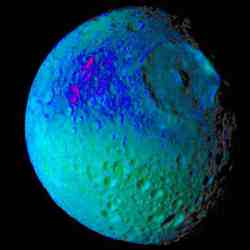
False color image of Mimas. Image credit: NASA/JPL/SSI Click to enlarge
On its recent close flyby of Mimas, the Cassini spacecraft found the Saturnian moon looking battered and bruised, with a surface that may be the most heavily cratered in the Saturn system.
The Aug. 2 flyby of Saturn’s “Death Star” moon returned eye-catching images of its most distinctive feature, the spectacular 140-kilometer diameter (87-mile) landslide-filled Hershel crater. Numerous rounded and worn-out craters, craters within other craters and long grooves reminiscent of those seen on asteroids are also seen in the new images.
The new Mimas images are available at http://saturn.jpl.nasa.gov, http://www.nasa.gov/cassini and http://ciclops.org . Also available is an approach movie showing Mimas, and a zoom and pan across the surface of one of the highest resolution images.
The closest images show Mimas, measuring 397 kilometers (247 miles) across, in the finest detail yet seen. One dramatic view acquired near Cassini’s closest approach shows the moon against the backdrop of Saturn’s rings. A false color composite image reveals a region in blue and red of presumably different composition or texture just west of, and perhaps related to, the Hershel crater.
Scientists hope that analysis of the images will tell them how many crater-causing impactors have coursed through the Saturn system, and where those objects might have come from. There is also the suspicion, yet to be investigated, that the grooves, first discovered by NASA’s Voyager spacecraft but now seen up close, are related to the giant impact that caused the biggest crater of all, Herschel, on the opposite side of the moon.
The Cassini-Huygens mission is a cooperative project of NASA, the European Space Agency and the Italian Space Agency. The Jet Propulsion Laboratory, a division of the California Institute of Technology in Pasadena, manages the Cassini-Huygens mission for NASA’s Science Mission Directorate, Washington, D.C. The Cassini orbiter and its two onboard cameras were designed, developed and assembled at JPL. The imaging operations center is based at the Space Science Institute in Boulder, Colo.
Original Source: NASA News Release
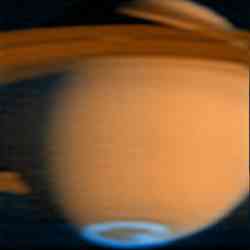
Saturn’s auroral emissions. Image credit: NASA/JPL/University of Colorado. Click to enlarge
New images of Saturn obtained by a University of Colorado at Boulder-led team on June 21 using an instrument on the Cassini spacecraft show auroral emissions at its poles similar to Earth’s Northern Lights.
Taken with the Ultraviolet Imaging Spectrograph aboard the Cassini orbiter, the two UV images, invisible to the human eye, are the first from the Cassini-Huygens mission to capture the entire “oval” of the auroral emissions at Saturn’s south pole. They also show similar emissions at Saturn’s north pole, according to CU-Boulder Professor Larry Esposito, principal investigator of the UVIS instrument built at CU-Boulder’s Laboratory for Atmospheric and Space Physics, and Professor Wayne Pryor of Central Arizona College, a UVIS team member and former CU graduate student.
In the false-color images, blue represents aurora emissions from hydrogen gas excited by electron bombardment, while red-orange represents reflected sunlight. The images show that the aurora lights at the polar regions respond rapidly to changes in the solar wind, said the researchers. Previous images have been taken closer to the equator, making it difficult to see the polar regions.
Major changes in the emissions inside the Saturn south-pole aurora are evident by comparing the two images, which were taken about one hour apart, they said. The brightest spot in the left aurora fades, and a bright spot appears in the middle of the aurora in the second image.
Made by slowly scanning the UVIS instrument across the planet, the images also contain more than 2,000 wavelengths of spectral information within each picture element. Researchers will use the wavelength information to study Saturn’s auroras, gases, and hazes and their changing distributions.
The UVIS observation team includes researchers from CU-Boulder, NASA’s Jet Propulsion Laboratory, Central Arizona College and the University of Southern California.
The Cassini-Huygens mission is a cooperative project of NASA, the European Space Agency and the Italian Space Agency. The Jet Propulsion Laboratory, a division of the California Institute of Technology in Pasadena, manages the Cassini- Huygens mission for NASA’s Space Science Mission Directorate in Washington, D.C.
More information on the Cassini-Huygens mission is available at the following Web sites: http://saturn.jpl.nasa.gov and http://www.nasa.gov/cassini.
Original Source: CU-Boulder News Release
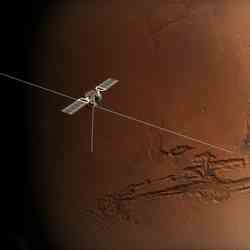
Artist’s impression of MARSIS deployment complete. Image credit: ESA Click to enlarge
MARSIS, the sounding radar on board ESA?s Mars Express spacecraft, is collecting the first data about the surface and the ionosphere of Mars.
The radar started its science operations on 4 July 2005, after the first phase of its commissioning was concluded on the same day. Due to the late deployment of MARSIS, it was decided to split the commissioning, originally planned to last four weeks, into two phases, one of which has just ended and the second one to be started by December this year.
This has given the instrument the chance to start scientific observations earlier than initially foreseen, while still in the Martian night. This is the environmental condition favourable to subsurface sounding, because the ionosphere is more ?energised? during the daytime and disturbs the radio signals used for subsurface observations.
From the beginning of the commissioning, the two 20-metre long antenna booms have been sending radio signals towards the Martian surface and receiving echoes back. ?The commissioning phase confirmed that the radar is working very well, and that it can be operated at full power without interfering with any of the spacecraft systems,? says Roberto Seu, Instrument Manager for MARSIS, from the University of Rome ?La Sapienza?, Italy.
MARSIS is a very complex instrument, capable of operating at different frequency bands. Lower frequencies are best suited to probe the subsurface and the highest frequencies are used to probe shallow subsurface depths, while all frequencies are suited to study the surface and the upper atmospheric layer of Mars.
?During the commissioning we have worked to test all transmission modes and optimise the radar performance around Mars,? says Prof. Giovanni Picardi, Principal Investigator for MARSIS, University of Rome ?La Sapienza?. ?The result is that since we have started the scientific observations in early July, we are receiving very clean surface echoes back, and first indication about the ionosphere.?
The MARSIS radar is designed to operate around the orbit ?pericentre?, when the spacecraft is closer to the planet?s surface. In each orbit, the radar has been switched on for 36 minutes around this point, dedicating the central 26 minutes to subsurface observations and the first and last five minutes of the slot to active ionosphere sounding.
Using the lower frequencies, MARSIS has been mainly investigating on the northern flat areas between 30? and 70? latitudes, at all longitudes. ?We are very satisfied about the way the radar is performing. In fact, the surface measurements taken so far match almost perfectly with the existing models of the Mars topography,? said Prof. Picardi. Thus, these measurements provided an excellent test.
The scientific reason to concentrate the first data analysis on flat regions lies in the fact that the subsurface layers here are in principle easier to identify, but the question is still tricky. ?As the radar is appearing to work so well for the surface, we have good reasons to think that the radio waves are correctly propagating also below the surface,? added Prof. Picardi.
?The biggest part of our work just started, as we now have to be sure that we clearly identify and isolate those echoes that come from the subsurface. To do this, we have to carefully screen all data and make sure that signals that could be interpreted as coming from different underground layers are not actually produced by surface irregularities. This will keep us occupied for a few more weeks at least.?
The first ionospheric measurements performed by MARSIS have also revealed some interesting preliminary findings. The radar responds directly to the number of charged particles composing the ionosphere (plasma). This has shown to be higher than expected at times.
?We are now analysing the data to find out if such measurements may result from sudden increases of solar activity, like the one observed on 14 July, or if we have to make new hypotheses. Only further analysis of the data can tell us,? said Jeffrey Plaut, Co-Principal Investigator, from NASA Jet Propulsion Laboratory, Pasadena, USA.
MARSIS will continue send signals to hit the surface and penetrate the subsurface until the middle of August, when the nighttime portion of the observations will have almost ended. After that, observation priority will be given to other Mars Express instruments that are best suited to work during daytime, such as the HRSC camera and the OMEGA mapping spectrometer.
However, MARSIS will continue surface and ionospheric investigations during daytime, with the ionospheric sounding being reserved for more than 20% percent of all Mars Express orbits, in all possible Sun illumination conditions.
In December 2005, the Mars Express orbit pericentre will enter the nighttime again. By then, the pericentre will have moved closer to the South pole, allowing MARSIS to restart optimal probing of the subsurface, this time in the southern hemisphere.
Original Source: ESA Portal
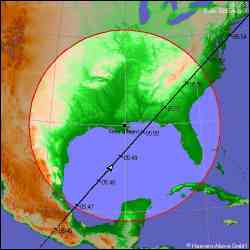
Discovery’s ground track on August 6th. Image credit: Chris Peat and Heavens Above. Click to enlarge
If you live in south Florida, central Texas or near the Mississippi River Delta, you’re in for a treat. This weekend the space shuttle Discovery and the International Space Station (ISS) are going to orbit over your part of the country. Shining like very bright stars, the two ships will glide in tandem across the sky–a lovely sight.
That’s the good news. The bad news is that you have to wake up before dawn to see them, but they’re worth waking up for.
The flybys commence on Saturday morning, August 6th, at 05:50 a.m. CDT when the pair can be seen from New Orleans, Mobile, Biloxi and surrounding areas. Discovery will have just undocked from the ISS about three hours earlier. This means the two ships will be separated, but still close together. Side by side apparitions of two bright spaceships are rare and beautiful.
“Based on their predicted separation of 7 km, their angular separation should be 1o–only twice the diameter of a full moon,” says independent satellite tracking expert Ted Molczan.
Which ship is which? The brighter light is the shuttle. Although Discovery is smaller than the ISS, its super-white top reflects more sunlight. Both ships should be easy to see in the deep-blue dawn sky.
Bonus: Discovery and the ISS, coincidentally, pass close to the planet Mars. If you’re an early riser, you’ve probably noticed Mars shining high in the sky before sunrise. If you haven’t noticed Mars yet, you will on August 6th. Discovery and the ISS will lead you right to the red planet: sky map.
August 7th should be a good morning, too, with flybys over south Florida, parts of Texas and Oklahoma. By then, says Molczan, “the two ships will be more than 250 km apart; the ISS would trail Discovery by 30 seconds or so — still worth observing, but not as spectacular as on August 6th.” Miami and Dallas are favored with particularly good apparitions: the two spaceships will be bright and, once again, close to Mars when they pass overhead.
Finally, on the morning of August 8th, the shuttle is due to land at the Kennedy Space Center. Reentry won’t be visible from much of the United States. The shuttle’s intended trajectory takes it over the Yucatan Peninsula and the Gulf of Mexico.
To the unaided eye, Discovery and the ISS are compact points of light. You can’t actually discern, e.g., the wings of the shuttle or the station’s vast solar arrays.
How about looking through a telescope?
It’s not easy, but it can be done. The two spaceships move slowly across the sky, taking about five minutes to cross from horizon to horizon. With a little practice, you can train a small telescope on the pair and manually track them. Then you can see their outlines. The space station’s T-shaped solar arrays are eye-catching; people who have seen them are impressed by their eerie copper color.
If you’ve never seen a shuttle flyby before, however, don’t spend precious minutes fumbling with a telescope. Look up and, using nothing but your eyes, simply enjoy the view.
Original Source: NASA News Release

Discovery’s heat shielding tiles. Image credit: NASA Click to enlarge
Space Shuttle Discovery?s heat shield is cleared for the return to Earth early Monday after mission managers decided today that a fourth spacewalk to deal with a puffed out thermal blanket is unnecessary. Wind tunnel tests overnight at NASA?s Ames Research Center in California showed little chance of any significant debris coming from the blanket at supersonic speeds. Further engineering analysis showed any debris released from the blanket was unlikely to hit structures on Discovery.
Thursday?s Mission Management Team decision put to rest the work that was being done to assess the health of the thermal protection system. The tiles and reinforced carbon-carbon on Discovery?s wings and nose were cleared earlier for entry.
Discovery and International Space Station crewmembers Thursday delivered a moving tribute to members of the Columbia crew and others, astronauts and cosmonauts, who lost their lives in the human exploration of space.
Each crewmember, in red shirt with Columbia’s STS-107 mission patch spoke during the tribute as the docked spacecraft flew over the southern Indian Ocean approaching a sunset. Station Science Officer John Phillips said: “To the crew of Columbia, as well as the crews of Challenger, Apollo 1, Soyuz 1 and 11, and to those who have courageously given so much, we now offer our enduring thanks.?
Mission Specialist Soichi Noguchi of the Japan Aerospace Exploration Agency repeated Phillips’ words in Japanese during the tribute, and Station Commander Sergei Krikalev spoke them in Russian. For the text of the tribute, please see:
http://www.nasa.gov/returntoflight/crew/sts114_exp11_tribute.html
After their successful Wednesday spacewalk, Discovery and Station crewmembers continued transfer activities, mostly packing the Multi-Purpose Logistic Module Raffaello with items from the Station. The pressurized cargo carrier is to be unberthed Friday from the Station’s Unity Node and returned to Discovery’s cargo bay for the trip back to Earth.
Pilot Jim Kelly and Mission Specialist Wendy Lawrence attached the Station’s Canadarm2 to Raffaello in preparation for its unberthing.
Discovery Commander Eileen Collins, spacewalking Mission Specialist Steve Robinson and Mission Specialist Charlie Carmada talked with reporters from the Associated Press and NBC. A little later Collins and Noguchi spoke with Japanese Prime Minister Junichiro Koizumi, Japanese astronaut Mamoru Mohri and others, including Japanese students.
Crewmembers had an hour together for a common meal, then the seven Discovery astronauts had the afternoon off. The Station crew spent about two hours preparing equipment for the unberthing of Raffaello.
Original Source: NASA News Release